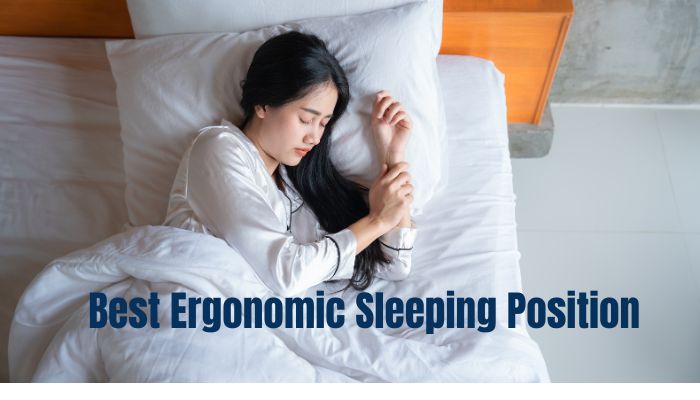Discover the secret to a perfect night’s rest! Dive into our expert insights on the best ergonomic sleeping positions to improve sleep quality and reduce body strain.
Introduction: The Importance of an Ergonomic Sleeping Position
Did you ever wonder why you woke up with a crick in your neck or a sore back? The answer might be in how you sleep. Ensuring an ergonomic sleeping position can be the difference between waking up refreshed and waking up with aches.
The Science Behind Sleep Ergonomics
Our bodies are like intricate machines, and just like machines, alignment matters.
- The Connection between Sleep and Spine Health
Our spine is a complex structure, and when we lay down, its position can influence everything from muscle tension to nerve health. Proper spinal alignment during sleep promotes healthy circulation and reduces the risk of musculoskeletal pain. - How Sleep Positions Affect Our Muscles and Joints
Incorrect sleeping postures can place undue stress on our muscles and joints, leading to morning stiffness or even long-term issues. This is why understanding the science of sleep ergonomics is crucial.
Side Sleeping: Benefits and How to Optimize
One of the most popular sleep positions, side sleeping has its set of pros and cons.
- Advantages of Side Sleeping
It promotes better circulation, potentially reduces snoring, and can be ideal for those with certain medical conditions. - Common Mistakes and How to Correct Them
A common error is not supporting the neck or the space between the waist and the mattress. Ensure your pillow is not too high or too low, and consider a small pillow or rolled towel at your waist. - The Right Pillow and Mattress for Side Sleepers
Memory foam pillows that contour to the shape of your head and neck can be beneficial. Similarly, a medium-firm mattress can provide the right blend of support and cushioning.
Back Sleeping: The Natural Posture and Its Advantages
Ever noticed how babies often sleep on their backs? There’s a reason for it.
- Why It’s Considered Natural
Back sleeping allows for neutral spine alignment, which can prevent many musculoskeletal problems. - Benefits for Spinal Health
It provides an even distribution of weight, reducing pressure points. Moreover, it helps in maintaining a neutral neck position, which is vital for avoiding neck pain. - Tips for Optimal Back Sleeping
Use a pillow that doesn’t prop your head up too much. Ensure your mattress provides adequate support, keeping your spine aligned.
Other Sleeping Positions and Their Impacts
While side and back sleeping is popular, there are others to consider.
- Stomach Sleeping: Pros and Cons
While some find relief from snoring or sleep apnea in this position, it’s typically not recommended due to the strain it places on the neck and spine. - Fetal Position: What to Know
This position, curled up like a fetus, can be comforting for many but can also restrict deep breathing and put stress on your spine and hips.
Ergonomic Sleep Accessories to Enhance Sleep Quality
Enhancing your sleep quality goes beyond just your position.
- Mattresses: How to Choose the Right One
Look for those that offer good support while contouring to your body’s shape. Remember, it’s an investment in your health. - Pillows: The Role They Play
They should support your head and neck in a neutral position. Regularly assess them for wear and replace them when needed.
Stomach Sleeping: Understanding the Controversies
Sleeping on one’s stomach is like the wild card of sleeping positions: some swear by it, while experts often caution against it.
- The Good Side of Stomach Sleeping
For some, stomach sleeping can provide relief from snoring and certain types of sleep apnea. It can also offer a feeling of comfort and security for many. - Potential Downsides and Health Risks
However, the main concern with stomach sleeping is the strain it puts on the spine and neck. Our spine has a natural curve, and lying on the stomach can flatten the natural arch, leading to pain. Moreover, turning the neck to one side for extended periods can result in neck strains.
Read more about Best Sleeping Position For Chiari Malformation | Medical Tips
How Pillows and Mattresses Affect Your Sleeping Posture
Ever wonder why there are so many types of pillows and mattresses? It’s because they play pivotal roles in our sleep posture.
- The Role of Pillows
Pillows should support the head and neck without elevating the head excessively. For stomach sleepers, a thin pillow—or even no pillow at all—may be best. The aim is to keep the spine as neutral as possible. - Mattress Dynamics
A soft mattress that allows the body to sink might exacerbate the spinal misalignment of stomach sleepers. A firmer mattress can provide the necessary support, keeping the spine relatively neutral.

Tips for Transitioning to a New Sleeping Position
Sometimes, for health or comfort reasons, a change in sleep position becomes essential.
- Why Consider a Change?
If you’re waking up with stiffness, pain, or other sleep-related issues, it might be time to reconsider your sleeping position. - Steps to Shift Your Sleep Style
- Start Gradually: Transitioning from stomach to side sleeping can be easier than moving directly to back sleeping. Using body pillows can help maintain the new position.
- Create a Restful Environment: Ensure the room is dark, quiet, and at a comfortable temperature.
- Reassess Your Sleep Accessories: If you’re switching positions, you might need to change your pillow or mattress type.
- Stay Consistent: Like any habit, consistency is key. It might feel odd initially, but over time, the new position can become your default.
The Connection Between Sleeping Posture and Sleep Disorders
We spend about a third of our lives sleeping. Why? It’s simple. Sleep is essential for our well-being. Yet, how we sleep can greatly influence the quality of our slumber.
The Importance of Sleep
Imagine your body as a smartphone. Just as a phone needs to charge after extensive use, our bodies need rest to recharge and function optimally. Sleep plays a crucial role in memory consolidation, physical health, and emotional well-being. But did you ever think your sleeping position could make such a difference?
How Sleep Positions Affect Quality of Sleep
It’s not just about getting eight hours of sleep; it’s also about how you’re positioned. Just as a chair can determine your posture while working, your sleep position influences your body’s alignment and sleep quality.
Understanding Sleep Postures
Everyone has a favorite position they naturally gravitate towards. Here’s a peek into the most common ones:
The Fetal Position
Curling up like a baby might seem cozy, but is it beneficial? For most, this position aids in reducing snoring and can be a boon for pregnant women. However, ensure it doesn’t strain your hips or knees.
Sleeping on Your Back
Often termed the ‘royal’ sleep position, lying on your back with arms by the side is great for spine and neck health. But beware, back sleepers! This position might increase the chances of snoring and sleep apnea.
Sleeping on Your Stomach
Stomach sleepers, it’s a tricky one for you. While it can decrease snoring, it may also strain your neck and back.
Common Myths about Sleeping Positions
Myth 1: One-size-fits-all Sleep Position
Remember when you tried on that “one size fits all” cap? Chances are, it didn’t quite fit. Similarly, there’s no universal best sleeping position. It’s all about what’s comfortable and beneficial for you.
Myth 2: Sleeping on the Left Side Aids Digestion
While some argue that lying on the left can benefit digestion due to gravity’s role in the digestive process, there’s no concrete evidence to solidify this claim.
Myth 3: Back Sleepers Snore More
Yes, back sleeping can lead to snoring, but it’s not the sole cause. Factors like nasal congestion, obesity, and alcohol consumption can also be culprits.
Sleep Disorders Linked to Sleeping Positions
Sleep Apnea
Characterized by breathing interruptions during sleep, sleep apnea can be exacerbated by back sleeping due to the tongue falling back, obstructing the airway.
Neck and Back Pain
Your spine craves alignment. Sleeping in a twisted or unsupported posture can lead to chronic pain issues.
Conclusion: Steps to Achieve Your Ideal Sleeping Posture
Practical Tips for a Good Night’s Rest
Finding your ideal sleep posture is a journey, not a destination. Be open to experimenting. Listen to your body.
Using Pillows to Your Advantage
A pillow isn’t just for your head. Placing one between your knees or under your lower back can provide additional support.
The Role of the Sleep Environment
Ever tried sleeping in a noisy or lit room? Your environment plays a pivotal role. Ensure a calm, dark, and cool room for a restful night.
FAQs
- Is it bad to sleep without a pillow?
- It depends on your sleeping position. For stomach sleepers, going pillowless can be beneficial for the spine. However, side and back sleepers might need that extra support.
- How often should I change my sleeping posture?
- If you’re experiencing discomfort or disruptions in sleep, it’s worth considering a change. However, gradual transitions are key.
- Can I train myself to sleep in a different position?
- Yes, with consistent effort and the right tools, you can adapt to a new sleeping position over time.
- Why do I move so much during sleep?
- Movement can be a sign of restless sleep. Factors like stress, sleep disorders, or discomfort can contribute.
- Do sleeping positions influence dreams?
- While there’s no concrete evidence, some believe that certain positions, like sleeping on the stomach, might induce more vivid dreams.
